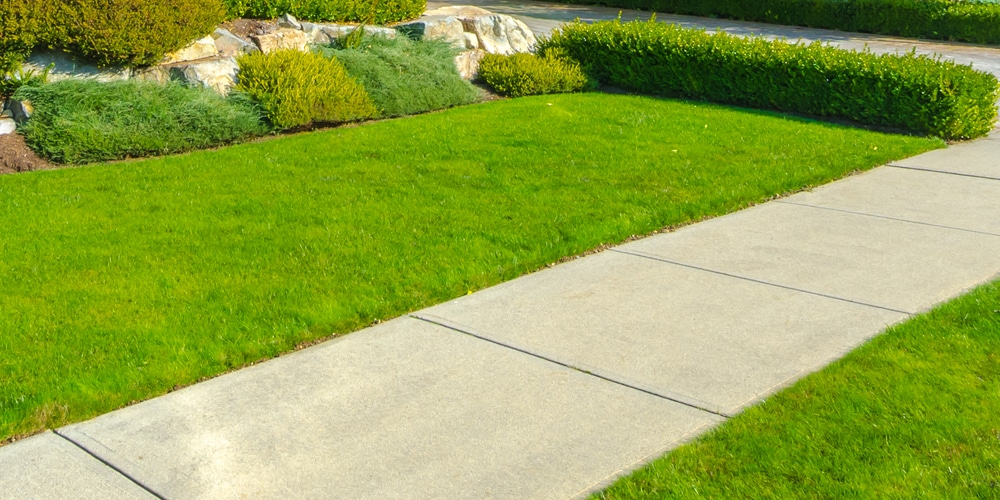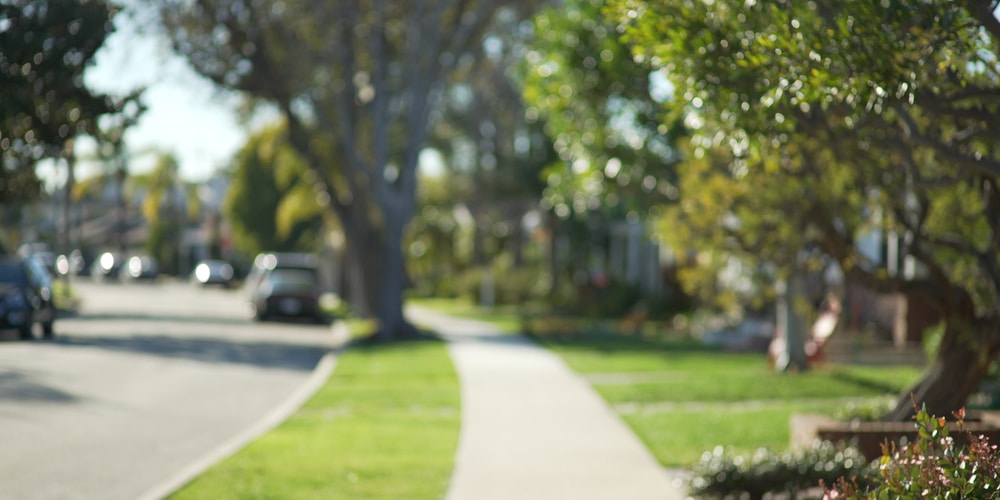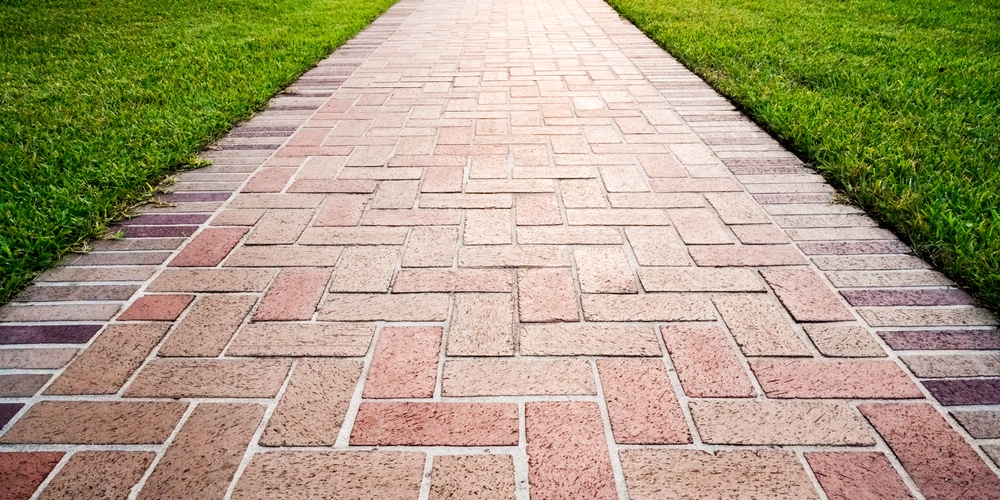A question that has puzzled many people is ‘who owns the grass between the sidewalk and curb and whether or not homeowners are responsible for the maintenance of the area directly in front of their homes. These areas are common in towns and villages across the country and are referred to as a “common-area easement.”
The term generally refers to the strip of land on which a sidewalk and street will be located. For example, when a new house is built, the driveway is constructed to exit on a particular street. There are several feet of “easement” space between where the building ends and where the road begins. Usually, this area is landscaped with grass, shrubs, or some other kind of ground cover. Let’s look at who owns the grass between the sidewalk and the curb.
Common-area easement explained

This common-area easement is owned by the municipality in which it is located. For this reason, if the grass between the sidewalk and the curb is not properly maintained by either the municipal or its residence, then all citizens of that municipality are adversely affected.
Maintaining this space to an attractive level promotes a better community image, enhancing each citizen’s quality of life. For this reason, it’s within the interests of the community that the grass is well maintained. It’s quite common for the residence of an area to wonder who job the maintenance.
Whose responsibility is it to maintain the grass between the sidewalk and curb?
This question can become extremely complex if multiple homeowners are involved. For example, if the common-area easement runs in front of each property owned by six homeowners, is each responsible for maintaining an equal amount of grass? Who decides where the sidewalk will be located? Will the municipality place responsibility on one owner to maintain more than another? These are all questions related to the maintenance of the common-area easement that must be answered by the City Council. The answer to the question is also likely to vary from city to city.
It would be highly beneficial to have a telephone call, meeting, or get-together with your Mayor and City Council to find out what the rules are regarding this issue. If this cannot occur, try to phone or email them so that you can better understand these rules and their implications.
It is important to realize that many communities have adopted a particular size as the standard width of a common-area easement. In these cases, homeowners are responsible for maintaining only the grass on the side of their property closest to the street.
If this situation applies to your municipality, it would be wise to determine the width of your common-area easement and remember that it is always subject to change. Regardless of its size, you can help beautify this space between the sidewalk and the curb by keeping grass clippings off the sidewalk. You may also like to plant low-maintenance species such as ground cover or ornamental grasses instead of turfgrasses.
How to keep the area between the sidewalk and curb tidy
Here are some simple rules that most municipals would like residence to follow when it comes to maintaining the area along the edge of the sidewalk, regardless of who owns the grass between the sidewalk and the curb.
- Don’t leave grass clipping or plant cuttings in common area or on the sidewalk.
- Ensure that your garden hose isn’t watering over onto the sidewalk or street as this could soak or block passers-by.
- Don’t let fertilizer or other chemicals run onto the sidewalk.
By following these simple guidelines, you’ll help keep your community looking great. No matter what size your common-area easement is, you are responsible for its appearance!
Conclusion
Make sure you know what your city municipal says about the common-area easement. This is a critical issue that can affect all homeowners within the municipality. In some cases, the municipal will maintain the grass between the sidewalk and the curb, while in other areas, it’s homeowners’ responsibility.
Contact your Mayor and City Council and explain the problems that litter and uncut grass create for everyone in the community. Be sure to keep lawn clippings off the sidewalk and establish attractive ground cover instead of turf grasses within this area.
Bonus: Sampling of State Statues
Here are some examples of sidewalk laws in different states and cities, which can help you determine who owns the land between the sidewalk and the curb in your area. Push command F or control F to find your State (if I could find an applicable law related to who owns the grass between the sidewalk and the curb, I threw it in here).
Montana: According to Chapter 7.6 of regulations related to Title 70 (the state building code), sidewalks next to private property are considered “private ways” and the property owner is responsible for maintenance.
Nebraska: “Cities can’t remove, obstruct or interfere with curbing, sidewalks and drainage facilities that abut city streets unless they give notice and then compensate the adjacent property owner.” (from Chapter 17, Article 11 of Nebraska State Statutes)
Vermont: Publicly owned sidewalks and curbs in the state of Vermont belong to local governments.
Wisconsin: “the property owner abutting a street has no responsibility for the construction or maintenance of sidewalks” (from Chapter 86, Section 67 of Wisconsin State Statutes)
Illinois: The Illinois Department of Transportation’s Code of Practice requires that every owner of property that abuts a county state roadway maintain the property as follows: “all driveway aprons and access ramps; curbs and gutters; sidewalks and driveways (including new, replacement and reseeded portions); and all drainage facilities and structures.” See Section 4.17 of IDOT’s Code of Practice [2]
Alaska: The Alaska Department of Transportation & Public Facilities says on its website that property owners are responsible for the sidewalks adjacent to their properties. [3]
Arizona: Here is some information about sidewalk maintenance in Arizona. It’s not 100% clear which state agency has jurisdiction, but it looks like it’s City Hall. Specifically, this webpage states “City code requires property owners to maintain sidewalks, curbs and gutters next to their properties.” The sidewalk maintenance policy states “Property owners are responsible for the sidewalk relief area adjacent to their lots. This means keeping it free of obstructions, safe for use by pedestrians and maintained in good condition at all times.” It sounds like the city just assumes ownership if the property owner doesn’t take ownership, but it’s not clear.
Arkansas: According to the City of Little Rock website, “property owners must maintain sidewalks adjacent to their properties at their own expense.”
Colorado: The state code specifies curbing and sidewalk design requirements for counties, municipalities and road authorities. Property owners may have responsibilities for sidewalks.
Georgia: According to the City of Atlanta website, “property owners are responsible for maintaining sidewalks adjacent to their property at their own expense.” This is also mentioned in this FAQ.
Indiana: The Indiana Department of Transportation has a policy that requires property owners to maintain sidewalks next to their properties. Section 718 says “When sidewalks abut or adjoin State highways, the owner of the abutting property shall maintain those parts of such sidewalk which are within the sidewalk relief area.”
Iowa: “as determined by the city council” (through state legislation). Who owns the grass between the sidewalk and the curb is a little muddy here.
Kentucky: This information is from a 2012 blog post : “Most cities and counties have adopted ordinances which place responsibility for sidewalk repair upon the owner of the property abutting the sidewalk.”
Maryland: According to Section 27105 of Maryland state code, “Each county or municipality shall remove snow and ice from sidewalks along highways under their jurisdiction within a reasonable time after any snowfall. Any property owner who fails to clear a sidewalk in a reasonable time shall be responsible for any expense incurred by the county or municipality in removing snow and ice from the sidewalk.” [4]
Michigan: According to Lansing City Council Member, Jessica Yorko, “We have our own city bureaucracy regarding sidewalks. It’s typically dealt with at the city level, so you’d have to check with the local city.”
Missouri: According to the City of St. Louis website, “The City Code states that ‘property owners shall maintain the sidewalk adjacent to their property at their own expense.'” It sounds like this is enforced by state law.
Nebraska: Property owners are responsible for sidewalk maintenance, but they can ask the city to do the job and the city is required to comply. If not, then people can report problems.
Nevada: According to the City of Reno website, “City code does require that property owners maintain sidewalks adjacent to their properties at their own expense.”
New Mexico: Property owners are responsible for sidewalk maintenance as well as snow removal. This is also mentioned in this FAQ.
New York: According to the New York City Department of Transportation website, “Under city codes, property owners are responsible for snow and ice removal.”
North Carolina: The North Carolina State Highway Patrol has policy that requires property owners to maintain sidewalks next to their properties. Section 1A1, Rule 11 says “The abutting property owner and/or occupant shall be responsible for the care and upkeep of all sidewalks in front of his property.”
North Dakota: According to the City of Fargo website, “For unincorporated areas of Cass County, we recommend that residents contact their county Commissioner for information regarding any specific resolutions/ordinances dealing with snow removal from the rightofway.”
Oklahoma: The Oklahoma Department of Transportation website says “In most cases, it is the responsibility of the abutting property owner to maintain sidewalks.” It’s also mentioned here.
Oregon: According to the City of Portland Bureau of Transportation website, “The City Code states that ‘property owners are responsible for removing snow and ice from sidewalks abutting their property within a reasonable amount of time.'”
Pennsylvania: Property owners in Philadelphia are responsible for sidewalk maintenance, snow removal, etc. This is also mentioned in this FAQ.
Rhode Island: According to the City of Providence website, “The sidewalk in front of your property is your responsibility. The City does not clear private sidewalks.”
South Carolina: According to an article from the South Carolina Department of Transportation, “In those areas where there are no sidewalks, pedestrians should walk on the shoulder as close as possible to the edge of the pavement.” In Greenville County’s list of laws governing sidewalk maintenance it says that if a homeowner fails to maintain a sidewalk then they will be given notice and allowed 30 days before enforcement takes place.
Tennessee: Property owners are responsible for snow removal and/or could face criminal charges. This is also mentioned in this FAQ.
Texas: Property owners are responsible for removing snow and ice from their sidewalks and can be fined for not doing so.
Related: How to Transplant Grass: A Guide to Laying Sod

